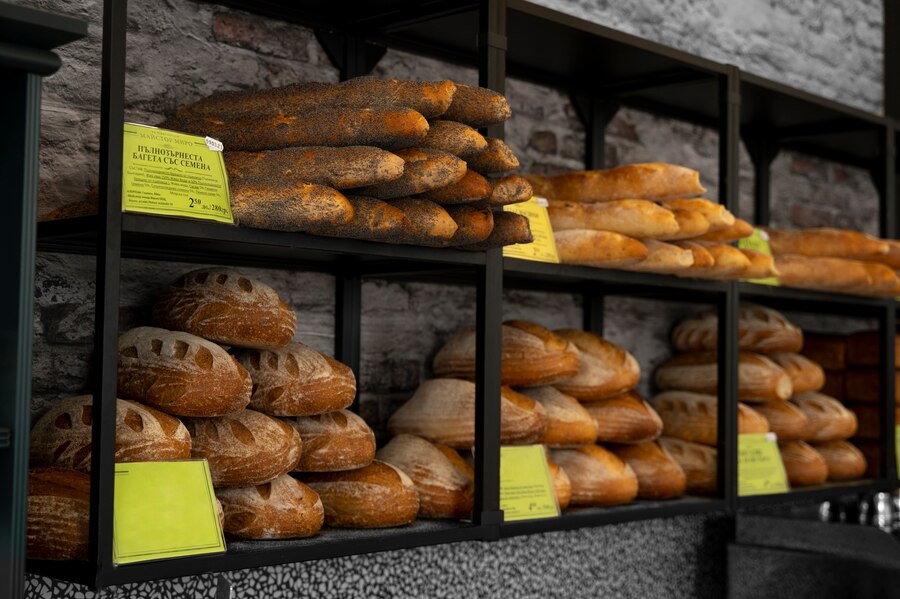Homemade bread holds a special place in our hearts. Its aroma fills the house with warmth, and the effort behind each loaf connects us to a timeless tradition. Yet, the shelf life of homemade bread is short, raising the question: how can we preserve it sustainably? In this guide, I will walk you through practical methods, backed by research and personal experiences, to keep your bread fresh while minimizing environmental impact.

Why Homemade Bread Needs Special Attention
Unlike store-bought bread, which often contains preservatives, homemade bread is free of artificial additives. This purity comes with a trade-off: a shorter shelf life. Without the stabilizers and additives that extend commercial bread’s usability, homemade bread stales within 2-3 days and risks moulding within a week, depending on storage conditions. These characteristics demand thoughtful preservation techniques to extend its life without compromising on quality.
Homemade bread’s vulnerability is not just a personal inconvenience but a global concern. A 2024 study published in the Journal of Cleaner Production revealed that bread accounts for approximately 10% of global food waste. By employing effective preservation strategies, we can combat this waste and contribute to sustainability.
The Science of Bread Staling and Spoilage
To preserve bread effectively, it helps to understand the science behind why it deteriorates. Two main processes affect bread: staling and spoilage.
- Staling: The staling of bread is caused by the retrogradation of starch molecules. After baking, starch in bread gelatinizes, creating its soft texture. Over time, these molecules recrystallize, leading to hardness and dryness—a process that accelerates in colder environments, such as the refrigerator.
- Spoilage: Mold growth is another common issue. It occurs due to exposure to airborne spores and moisture. Warm and humid conditions exacerbate the risk of mould, making proper storage crucial.
Temperature and Humidity: Key Factors
Both temperature and humidity significantly influence bread’s shelf life. Below is a comparison of how storage environments affect staling and spoilage:
| Storage Condition | Staling Rate | Mold Growth Likelihood |
|---|---|---|
| Room Temperature | Moderate | High |
| Refrigerator (4°C) | Fast | Low |
| Freezer (-18°C) | None | None |
From the table, it’s clear that room temperature storage balances freshness and mould prevention for short-term use, while freezing is optimal for long-term preservation. Refrigeration, though common, often worsens staling, making it less ideal unless humidity is very high.
Key Insight
Freezing bread halts both staling and spoilage processes, making it an excellent sustainable option. By slicing bread before freezing, you can defrost only what you need, further reducing waste and maintaining quality. This practice ensures that every slice of your homemade bread remains as delightful as the moment it emerged from the oven.
Learn More: 10 Sustainable Food Practices Examples: A Comprehensive Guide to Green Living
Sustainable Methods for Bread Preservation
1. Freezing Bread for Long-Term Storage
Freezing is undoubtedly the most reliable way to keep homemade bread fresh for extended periods. When done sustainably, it not only prevents food waste but also reduces your environmental impact. Here are detailed steps to make freezing a sustainable practice:
Slice Before Freezing
Slicing the bread prior to freezing is a game-changer. It allows you to defrost only the amount you need, reducing unnecessary waste and maintaining the bread’s quality. Whole loaves often require more time and energy to thaw, and once thawed, they’re prone to spoilage if not consumed quickly.
Use Reusable Bags
Instead of resorting to single-use plastic bags, opt for durable, reusable alternatives like silicone bags or cloth freezer bags. Silicone bags are particularly effective as they create an airtight seal, keeping the bread fresh and free from freezer burn. Cloth bags lined with wax paper can also work, offering a biodegradable option.
Personal Tip: Three years ago, I switched to silicone freezer bags, and it’s been a transformative experience. They’re easy to clean, last for years, and keep my bread tasting as if it were freshly baked. The initial investment pays off in both environmental savings and bread quality.
Minimize Energy Waste
To freeze bread sustainably, think about energy efficiency. Avoid freezing small batches multiple times, as frequent freezer door openings waste energy. Instead, freeze bread in larger batches or plan your baking schedule to coincide with available freezer space. Grouping similar items together in the freezer can also help maintain consistent temperatures, reducing energy demand.
Defrosting Tips
When ready to use, defrost slices on the counter for 15-30 minutes or warm them gently in a toaster. This reduces energy consumption compared to defrosting entire loaves in the oven. By thinking ahead, you can enjoy fresh-tasting bread with minimal environmental impact.
2. Room-Temperature Storage for Short-Term Freshness
If you plan to consume your bread within a few days, room-temperature storage is a sustainable option. Proper techniques can extend the bread’s freshness without requiring refrigeration or freezing.
Wrap it Right
Using breathable materials like beeswax wraps or clean kitchen towels helps shield bread from air and moisture while allowing it to breathe. Beeswax wraps, in particular, are reusable, biodegradable, and an excellent alternative to plastic. These wraps mould to the shape of your loaf, ensuring comprehensive coverage and reducing exposure to drying air.
Store in a Bread Box
A wooden bread box is a classic storage solution that combines functionality with sustainability. Bread boxes create a balanced environment—they shield bread from excessive air exposure while preventing the buildup of trapped moisture, which can lead to mould. If you don’t have a bread box, a cotton bread bag can serve as an effective substitute.
Avoid Plastic Bags
Plastic bags trap moisture, accelerating mould growth. While they might keep bread soft temporarily, their environmental cost and short-term efficacy make them a poor choice. By using sustainable alternatives, you’ll not only preserve your bread better but also reduce plastic waste.
Pro Tip for Humid Climates
In areas with high humidity, combine room-temperature storage with additional precautions. Place a piece of parchment paper inside the wrap or bag to absorb excess moisture.
3. Refrigeration: Use Sparingly
Refrigeration is a polarizing topic in the world of bread storage. While it can delay mould growth in particularly humid climates, it also accelerates staling due to starch retrogradation. Use this method only when necessary, and follow these tips for best results:
Double Wrap
To combat the drying effects of refrigeration, double-wrap your bread. Start with a beeswax wrap for direct contact, followed by a cloth bag for an extra layer of protection. This combination minimizes moisture loss while preventing mould.
Rehydrate Before Eating
Refrigerated bread often becomes dry and crumbly. To revive it, lightly mist the loaf with water and warm it in an oven at 180°C (350°F) for 5-10 minutes. This process restores moisture and refreshes the texture, making the bread nearly as good as fresh.
Expert Quote: “Refrigerators are bread’s enemy, except in extreme humidity. When using this method, balance is everything.” — Dr. Emily Carter, Food Scientist
4. Creative Repurposing
Despite your best efforts, some bread will inevitably go stale. Instead of discarding it, repurpose it into new dishes. This not only reduces waste but also expands your culinary repertoire.
Breadcrumbs
Turn stale bread into breadcrumbs by drying it in the oven and processing it in a blender or food processor. Breadcrumbs can be stored for months and used in various recipes, from coating for fried foods to thickening soups.
Croutons
Cube stale bread, toss it with olive oil, herbs, and spices, and bake until golden. These homemade croutons are perfect for salads, soups, or even as a snack.
Bread Pudding
Bread pudding is a versatile dish that can be sweet or savoury. Combine chunks of stale bread with a custard mixture, then bake until set. Additions like raisins, cinnamon, or cheese can elevate the dish.
Personal Story: A few months ago, I accidentally left a baguette out overnight. Instead of tossing it, I transformed it into crispy, herb-seasoned croutons. Paired with a garden-fresh salad, they became the highlight of our family dinner. This simple act turned a potential waste into a memorable meal.
The Sustainability Angle
Repurposing stale bread significantly reduces food waste. According to the Food and Agriculture Organization (FAO), approximately one-third of all food produced globally is wasted. Bread accounts for a notable portion of this waste. By adopting creative reuse strategies, you’re contributing to a more sustainable food system.
The Environmental Impact of Bread Preservation
Comparative Energy Use and Waste Reduction Potential
| Preservation Method | Energy Use (kWh/year) | Waste Reduction Potential |
|---|---|---|
| Freezing (Reusable Bags) | ~5 | High |
| Room Temperature (Bread Box) | ~0 | Moderate |
| Refrigeration | ~50 | Low |
These figures reveal a balance between energy consumption and food waste reduction. Freezing bread consumes minimal energy (around 5 kWh per year if you’re using reusable bags and optimizing freezer efficiency) but can drastically cut down on waste by preserving bread for months. Refrigeration, by contrast, uses more energy while being less effective at maintaining quality, making it a less sustainable choice overall. Room-temperature storage has negligible energy use but offers limited waste prevention as bread may stale or mould faster.
Analysis: Why Freezing Is a Net Positive
Freezing stands out as the most sustainable option when done efficiently. By preventing spoilage, it reduces the need to bake or purchase new bread, indirectly cutting down on energy, water, and resources used in bread production. However, sustainable freezing practices are essential:
- Reusable Materials: Opt for silicone or durable cloth bags instead of single-use plastic.
- Batch Freezing: Store multiple items at once to minimize energy loss from frequent freezer door openings.
- Defrost Smartly: Thaw only what you need to avoid waste.
Learn More: 15 Zero-Waste Examples: Practical Steps for a Sustainable Lifestyle
Tips for Sustainable Baking and Consumption
Preserving bread isn’t just about storage; it’s also about aligning your baking and consumption habits with sustainable practices. Here are actionable steps to help:
1. Bake Smaller Loaves
One of the simplest ways to prevent waste is by baking smaller loaves tailored to your household’s consumption rate. A smaller loaf reduces the likelihood of leftovers that might go stale or mould before being eaten. It also saves energy, as you’re not overproducing.
Personal Tip: When I downsized the bread pans in my kitchen, I immediately noticed a reduction in unused bread. Smaller loaves are easier to finish within a few days, especially in a household of two.
2. Share Excess Bread
Excess bread doesn’t have to go to waste. Sharing surplus loaves with neighbours, friends, or local food pantries builds community while preventing waste. You’re not just helping the environment; you’re also spreading the joy of homemade bread.
Expert Insight: “Food sharing is one of the oldest and most sustainable practices. By redistributing excess, we reduce waste and foster stronger social connections.” — Dr. Rachel Green, Environmental Sociologist
3. Compost Moldy Bread
Even the most diligent efforts can sometimes fail to prevent spoilage. Composting mouldy bread ensures that nutrients return to the soil instead of rotting in a landfill, where they would emit methane, a potent greenhouse gas.
How to Compost Bread Safely:
- Break the bread into smaller pieces to speed up decomposition.
- Mix it with dry materials like leaves or cardboard to maintain balance in your compost pile.
4. Plan Ahead
Aligning your baking schedule with your household’s bread consumption is an underrated yet effective strategy. For instance, if you know your family consumes a loaf every three days, bake or purchase accordingly. Planning helps prevent overstocking and ensures that no loaf goes to waste.
Case Study: A Family’s Journey to Bread Sustainability
My family’s sustainability journey began with a realization: we were baking too much bread and throwing away leftovers. To address this, we adopted a two-pronged approach:
- Smaller Batches: We reduced our standard loaf size by 25%.
- Freezing Surplus: Any excess bread went straight into the freezer using silicone bags.
The results were immediate. Not only did we eliminate leftovers, but we also found ourselves enjoying fresher bread more consistently. Freezing also allowed us to diversify—we could bake multiple types of bread (whole grain, sourdough, etc.) and rotate through them without worrying about spoilage.
Actionable Advice: Your Sustainable Bread Preservation Checklist
To put these insights into action, use this simple checklist:
- Invest in Quality Storage:
- Reusable bags (e.g., silicone or cloth).
- Beeswax wraps for short-term storage.
- A well-ventilated wooden bread box.
- Choose the Right Preservation Method:
- Freeze for long-term storage.
- Use breathable wraps for room-temperature storage.
- Refrigerate only in extreme humidity.
- Repurpose Stale Bread:
- Make breadcrumbs, croutons, or bread pudding.
- Compost any spoiled bread responsibly.
- Be Intentional:
- Bake in quantities that match your household’s needs.
- Share surplus with friends or neighbours.
A Greener Future, One Loaf at a Time
By adopting sustainable preservation practices, you’re doing more than extending the life of your homemade bread. You’re reducing waste, conserving energy, and making choices that benefit both your household and the planet. Remember, every small step counts. Start with one method today and watch your habits transform—for good.







